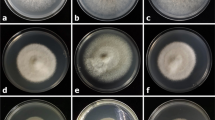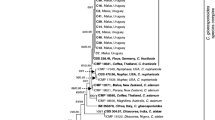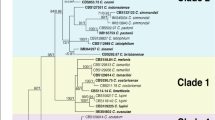Abstract
Molecular phylogenetic analysis, morphology and pathogenicity to citrus fruit were used to study two isolates of Elsinoë australis associated with scab-like symptoms on a fruit of Citrus australasica (finger lime) and Simmondsia chinensis (jojoba) in Australia. In addition to being associated with finger lime, the isolate from finger lime could cause scab symptoms on C. × aurantium cv. Murcott tangor in pathogenicity tests, but could not cause scab symptoms on the other orange, mandarin, lemon or grapefruit tested. Pathogenicity tests also support previous studies showing the isolate from jojoba could not produce symptoms on fruit of C. natsudaidai. Based on the findings of this study, two novel pathotypes of E. australis are designated from Australia; namely the Finger Lime (FL) pathotype associated with finger lime, and the Jojoba Black Scab (JBS) pathotype associated with black scab of jojoba. The significance of these novel E. australis pathotypes on market access and biosecurity issues for citrus are briefly discussed.



Similar content being viewed by others
References
Ash GJ, Stodart B, Hyun JW (2012) Black scab of jojoba (Simmondsia chinensis) in Australia caused by a putative new pathotype of Elsinoë australis. Plant Dis 96:629–634
Bitancourt AA, Jenkins AE (1937) Sweet orange fruit scab caused by Elsinoë australis. J Agric Res 54:1–18
Broadbent P (1995) Quarantine in relation to Australian citrus imports and exports. Australas Plant Pathol 24:145–156
Clarke K, Prakash N (2001) Floral morphology and embryology of two Australian species of Citrus (Rutaceae). Aust J Bot 49:199–207
Cunningham N (2002) Sooty mould cleaners and high pressure washing. Packer Newsl 67:1–3
de Bary A (1974) Über den sogenannten Brenner der Reben. Ann der Oenologie 4:165–167
Glienke C, Pereira OL, Stringari D, Fabris J, Kava-Cordeiro V, Galli-Terasawa L, Cunnington J, Shivas RG, Groenewald JZ, Crous PW (2011) Endophytic and pathogenic Phyllosticta species, with reference to those associated with Citrus Black Spot. Persoonia 26:47–56
Hou X, Huang F, Zhang T, Xu J, Hyde DK, Ll H (2014) Pathotypes and genetic diversity of Chinese collections of Elsinoë fawcettii causing citrus scab. J Integr Agric 13:1293–1302
Hyun JW, Timmer LW, Lee S-C, Yun S-H, Ko S-W, Kim KS (2001) Pathological characterization and molecular analysis of Elsinoë isolates causing scab diseases of citrus in Jeju Island in Korea. Plant Dis 85:1013–1017
Hyun JW, Yi SH, Mackenzie SJ, Timmer LW, Kim KS, Kang SK, Kwon HM, Lim HC (2009) Pathotypes and genetic relationship of worldwide collections of Elsinoë spp. causing scab diseases of citrus. Phytopathology 99:721–728
Jenkins AE, Bitancourt AA (1941) Revised descriptions of the genera Elsinoë and Sphaceloma. Mycologia 33:338–340
Kirk PM, Cannon PF, Minter DW, Stalper JA (2008) Dictionary of the Fungi, 10th edn. CABI International, Surrey
Kunta M, Rascoe J, de Sa P, Timmer LW, Palm ME, da Graca JV, Mangan RL, Mangan RL, Malik N, Salas B, Satpute A, Setamou M, Skaria M (2013) Sweet orange scab with a new scab disease “syndrome” of citrus in the USA associated with Elsinoë australis. Trop Plant Pathol 38:203–212
Raciborski M (1900) Parasitische Algen und Pilze Java’s. Batavia, Staatsdruckerei
Rayner RW (1970) A mycological colour chart. Kew, England. Commonwealth Mycological Institute
Ronquist FJ, Huelsenbeck JP (2003) MrBayes 3: Bayesian phylogenetic inference under mixed models. Bioinformatics 19:1572–1574
Saccardo PA, Sydow P (1902) Sylloge Fungorum omnium hucusque cognitorum. Digessit P.A. Saccardo 16:804
Stamatakis A (2006) RAxML-VI-HPC: maximum likelihood-based phylogenetic analyses with thousands of taxa and mixed models. Bioinformatics 22:2688–2690
Tamura K, Peterson D, Peterson N, Stecher G, Nei M, Kumar S (2011) MEGA5: molecular evolutionary genetics analysis using maximum likelihood, evolutionary distance, and maximum parsimony methods. Mol Biol Evol 28:2731–2739
Tan MK, Timmer LW, Broadbent P, Priest M, Cain P (1996) Differentiation by molecular analysis of Elsinoë spp. causing scab diseases of citrus and its epidemiological implications. Phytopathology 86:1039–1044
Taverner P (2012) Sodium o-phenylphenate tetrahydrate (SOPP). Packer Newsl 103:3–5
Taverner P, Cunningham N (1999) Sanitation survey of Riverland packingsheds. Packer Newsl 56:1–5
Timmer LW (2000) Scab diseases. In: Timmer LW, Garnsey SM, Graham JH (eds) Compendium of citrus diseases. APS Press, St Paul, pp 31–32
Timmer LW, Priest M, Broadbent P, Tan MK (1996) Morphological and pathological characterization of species of Elsinoë causing scab diseases of citrus. Phytopathology 86:1032–1038
USDA APHIS PPQ (2010) The significance of Citrus spp. fruit as a pathway for the introduction or spread of Elsinoë australis, the organism that causes Sweet orange scab disease. Raleigh, NC, USA. Center for Plant Health Science and Technology, Plant Epidemiology and Risk Analysis Laboratory
Wang L, Liao H, Bau H, Chung K (2009) Characterization of pathogenic variants of Elsinoë fawcettii of citrus implies the presence of new pathotypes and cryptic species in Florida. Can J Plant Pathol 31:28–37
White TJ, Bruns T, Lee S, Taylor J (1990) Amplification and direct sequencing of fungal ribosomal RNA genes for phylogenetics. In: Innis MA, Gelfand DH, Sninsky JJ, White TJ (eds) PCR protocols a guide to methods and applications. USA. Academic Press, San Diego, pp 315–322
Whiteside JO (1975) Biological characteristics of Elsinoë fawcettii pertaining to the epidemiology of sour orange scab. Phytopathology 65:1170–1175
Winston JR (1923) Citrus scab: its cause and control. Bulletin 118. Beltsville, MD, USA. United States Department of Agriculture
Acknowledgments
This research was partially funded by Horticulture Australia Limited using the citrus industry levy and matched funds from the Australian Government, and The University of Queensland, and the Queensland Department of Agriculture, Fisheries and Forestry. We wish to thank Dr. Mui Keng Tan and Dr. Nerida Donovan (NSW DPI) for providing the ‘jojoba black scab’ isolates. Dr. Jae-Wook Hyun (Rural Development Administration, National Institute of Horticultural & Herbal Science, Korea) for providing isolates of E. australis and E. fawcettii. Dr. Graeme Sanderson (NSW DPI) for providing the shoots of C. natsudaidai. Dr. Nerida Donovan (NSW DPI), Sylvia Jelinek (NSW DPI) and Tim Hermann (AusCitrus) for supplying various host plants. Dr. Jay Anderson (formerly DAFF Qld), Dr. Dean Beasley (DAFF Qld) and Cecilia O’Dwyer (UQ) for technical assistance, and Pat Barkley for advice on the manuscript.
Author information
Authors and Affiliations
Corresponding author
Additional information
Section Editor: Meike Piepenbring
Rights and permissions
About this article
Cite this article
Miles, A.K., Tan, Y.P., Shivas, R.G. et al. Novel Pathotypes of Elsinoë australis Associated with Citrus australasica and Simmondsia chinensis in Australia. Trop. plant pathol. 40, 26–34 (2015). https://doi.org/10.1007/s40858-015-0005-0
Received:
Accepted:
Published:
Issue Date:
DOI: https://doi.org/10.1007/s40858-015-0005-0




